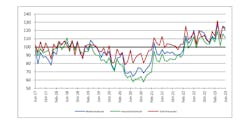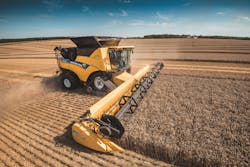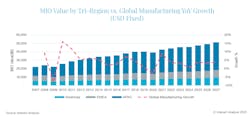The fluid power industry and its customer markets continued to see positive economic activity in the second quarter of 2023. While the rate of growth has slowed compared to the strong demand experienced the past 2 years, there has still been growth in many segments.
Second quarter financial reports from the fluid power industry, as well as its various customer markets, show manufacturers are still experiencing strong demand for their products.
Positive Quarterly Results for Fluid Power Manufacturers
The National Fluid Power Association's (NFPA) shipments data for the second quarter remained steady with a slight decline for total fluid power and hydraulics starting in June 2023 on a month-over-month basis. In general, shipments have declined slightly month over month throughout 2023 as markets have begun to normalize after the high levels of demand which began in 2020 and continued through much of 2021 and 2022 as the global economy rebounded from the COVID-19 pandemic.
Motion control and electronics company Helios Technologies Inc. reports a positive second quarter 2023. Revenue for its hydraulics segment was up 3% over the first quarter while its electronics business rose 15%. Total company revenue was up 7% for the quarter.
The company says sales to the agriculture, recreational, mining and aerospace industries benefited second quarter revenues.
For its hydraulics segment specifically, Helios reports a sales increase of 3% sequentially during the quarter and a rise of 7% from the same period a year ago. Acquisitions the company has made throughout the year helped drive the increase in sales. The Americas and EMEA (Europe, Middle East and Africa) were the regions with the strongest sales growth from the previous year, with the agricultural market providing the largest contribution.
Helios noted in its second quarter financial report that supply chain constraints continued to impact the business. "Expanding our capabilities enables us to better serve a more diversified global market. Our results in the quarter and year-to-date demonstrate this progress even against headwinds of the macroenvironment," said Helios’ President and Chief Executive Officer Josef Matosevic.
Parker Hannifin Corp.'s fiscal 2023 fourth quarter (ending June 30) saw a sales increase of 22% compared to the previous year. Its Aerospace Systems and Diversified Industrial segments, both of which are served by hydraulics and pneumatics components, saw increased sales during the quarter.
The North American Diversified Industrial Segment sales rose 10% while Aerospace Systems saw a sales increase of 90%.
Performance in Key Customer Markets
Fluid power serves a range of industries from manufacturing to heavy-duty mobile machinery such as construction equipment. Positive economic conditions in customer markets typically leads to positivity for hydraulics and pneumatics suppliers as well.
Data from NFPA shows Aerospace, Heavy-Duty Truck and Construction Machinery were among the top performing markets in the second quarter with increased shipments on both a month-over-month and year-over-year basis, as of June 2023.
Industrial Machinery also saw strong shipment numbers month-over-month, but were down slightly on a year-over-year basis. Other customer segments which faired well on both a month-over-month and year-over-year basis include Automobile, Light Truck and Utility Equipment; Material Handling Equipment and Ship and Boat Building.
Markets which saw declines include Metalworking Machinery; Mining, Oil, and Gas Field Machinery; and Turbine and Power Transmission Equipment. Each of these declined on a month-over-month basis but the Mining and Turbine markets were still up on a year-over-year basis.
Construction Equipment
Construction equipment is the largest customer market for fluid power components and systems, particularly hydraulics. Positive quarterly results from manufacturers in this market support NFPA's data showing increased fluid power shipments to this market and the continued strength of the construction equipment industry, due in large part to infrastructure projects around the world driving demand for machinery.
Volvo Construction Equipment (Volvo CE), for instance, has reported record earnings for the second quarter (Q2) of 2023. Despite declines in some markets, the company said in its press release announcing its Q2 results that global sales increased 12% during the quarter. Sales have been most robust in Europe, North America and Africa while China and Brazil are markets where declines have occurred.
Volvo CE said there are signs of demand weakening in some markets due to economic development and rising interest rates.
Major markets outside of China remained positive overall though for Volvo CE in Q2. In North America, the company has achieved year-to-date growth of 9% due to large infrastructure investments and strong commercial construction it stated in its press release. Europe is at a 4% year-to-date increase and growth has somewhat flattened because of a weaker macroeconomic outlook, elevated inflation and higher interest rates the company said.
The company said it does expect more challenging economic conditions in the coming months as cost inflation and increased supply chain disturbances take effect.
PALFINGER, a manufacturer of crane and lifting equipment, also reported strong results in Q2. The company said its first half of 2023 has been the best in company history to date. Declining raw material and freight prices aided PALFINGER's financial results as well as improvements in supply chains.
The company said North America continues to be a high growth market with strong demand for its service cranes and truck-mounted forklifts. EMEA, on the other hand, has been more of a struggle due to geopolitical and macroeconomic developments causing a decline in orders especially from the construction sector. However, the company said its high order backlog helped to provide stability.
Geopolitical and macroeconomic developments will continue to bring uncertainty and orders from the EMEA region are expected to be significantly lower than 2022 as the construction industry sees a decline in investments due to rising interest rates.
Agricultural Equipment
NFPA's June 2023 shipments data shows a slight level of growth for the Farm Machinery and Equipment sector on a month-over-month basis but year-over-year it has been the customer market with the highest level of declines. This is likely due in part to the agricultural equipment market turning toward a more positive direction.
According to the Association of Equipment Manufacturers (AEM), June is the first time total tractor sales were up on a year-over-year basis in the U.S. Sales for large tractors and combines have continued to be strong, but a small increase in sales for sub-40 hp two-wheel drive tractors helped bring the entire market into more positive territory. Year-to-date sales for tractors are down 9.7% but combines up 51.5% per AEM's data.
"Year-over-year sales comparisons this month are now starting to compare to 2022 sales that were closer to the 5-year average, and less informed by the aftereffects of the pandemic," said Curt Blades, senior vice president, industry sectors and product leadership at the Association of Equipment Manufacturers, in the association's press release announcing June agricultural equipment sales results. "At the same time, the continued strength in larger tractors and combines still owes some to the strength of commodities markets, and the appeal of more efficient technologies available on modern equipment."
CNH Industrial, a manufacturer of construction and agricultural machinery, reported its net sales for the agriculture business increased 4% during the second quarter. North America volume was up 21% year-over-year for tractors over 140 hp and down 8% for those under 140 hp. Combines were up 27% from the previous year. EMEA saw a 6% decline in tractor volume but combines were up 32%. Declines for both tractors and combines were seen in South America and Asia Pacific.
Agricultural equipment manufacturer AGCO said its second quarter sales were up 29.8% from the same period in 2022. The company's president and CEO Eric Hansotia said this was due to robust demand and favorable global industry conditions.
AGCO saw increased sales in each of its regions with EMEA and North America driving the highest levels of growth at 35.7% and 34.7% respectively. The first half of the year is also pacing ahead of 2022.
"Demand for larger agricultural equipment continues to be elevated with healthy farm income expected across the major agricultural production regions, and easing supply-chain constraints are enabling industry production to keep pace with demand," stated Hansotia in AGCO's press release announcing its Q2 results. "Commodity prices remain at supportive levels, but the recent volatility, due to uncertainty of current year crop production in the northern hemisphere, has influenced farmer sentiment of late."
The company noted in its press release that global industry production and retail tractor sales were down modestly in the first half of 2023 with sales weaker for smaller agricultural equipment, mirroring what was reported by AEM and CNH Industrial.
Manufacturing
The Institute for Supply Chain Management (ISM) reported further contraction of the manufacturing industry in June 2023. Contraction has occurred in this sector for the past 8 months after 28 months of growth. According to ISM, of the six largest manufacturing industries, transportation equipment was the only one to register growth in June.
Labor, a slowing U.S. economy, a reduction in customer orders and various global economic and geopolitical events are among the factors impacting the manufacturing industry.
Research firm Interact Analysis reported in April 2023 that a global slowdown for the manufacturing industry was predicted for 2026 but is more likely in 2024, with some of the effects already being felt. At that time, APAC was propping up much of the industry according to Interact Analysis. Rising oil and energy prices were among the factors negatively impacting other markets, particularly Europe.
The Americas is expected to fair well, due in part to efforts by the U.S. government to invest in manufacturing.
In July, Interact Analysis updated its data on the manufacturing sector which found China was still benefiting this market globally and will continue to do so in 2024. The semiconductor industry may present some challenges for this sector because of investment difficulties the research firm reports.
After years of strong growth, the semiconductor market has constricted as demand from the consumer electronics sector has lessened. Despite this, Interact Analysis notes orders for the machinery necessary to make this increasingly important product are growing. North America in particular is driving this order growth, partially because of policies such as the CHIPS and Science Act and Inflation Reduction Act providing funding for investments in more local production of semiconductors.
READ MORE: How the CHIPS and Science Act Will Benefit Fluid Power and Motion Control Manufacturers
What Lies Ahead for the Remainder of 2023?
A cooling period may be on the horizon for the later half of 2023 and into 2024. As Volvo CE noted in its Q2 financial report, it expects reduced demand in the coming months due to impacts from inflation and supply chains, among others.
A recent report from Reuters cited that while dealers for mobile equipment have had a difficult time keeping machines in stock because of strong demand and supply chain issues, there could soon be too much inventory on hand as demand decreases and manufacturers catch up with production.
Depending on the harvest season, income for farmers could be impacted, posing further potential challenges for the machinery market in the last half of the year.
The ITR Economics third quarter 2023 forecast for NFPA continues to show an increase in fluid power shipments of 3.2%. However, in 2024 a decline of 10.9% is predicted. This is due to growth rates declining in the many markets served by hydraulics and pneumatics. High interest rates are a reason for this in industries such as construction; single-family residential construction is being negatively impacted and therefore reducing demand for the construction sector.
The fluid power industry and many of its customer markets should end 2023 on a positive note before the declines in growth forecast for hydraulics and pneumatics as well as most of the industry's customer markets in 2024. But positivity is expected to return again in 2025 for fluid power and the majority of its markets.







